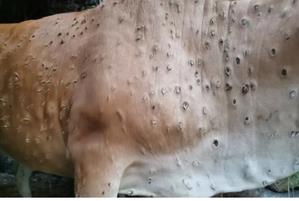
73 Cases Of Lumpy Skin Disease Reported In Namibia
There have been 73 confirmed cases of the disease, a debilitating viral infection that affects cattle, in the Otjombinde Constituency within the Epukiro Veterinary District in the Omaheke Region of eastern Namibia, Johannes Shoopala, acting chief veterinary officer at the DVS, said in a statement.
"LSD is a state-controlled disease, and wherever it occurs, it must be reported to the nearest state veterinarian," he said.
According to Shoopala, LSD is transmitted by blood-feeding insects such as flies, mosquitoes, and ticks.
He noted that depending on the epidemiological situation of the area, local state veterinarians are empowered by law to implement control measures to safeguard the livestock industry, which may include quarantine of the affected area, vaccination of all in-contact animals with the recommended vaccine, and treatment of all animals showing symptoms of LSD, Xinhua news agency reported.
"The directorate is strongly advising farmers countrywide to vaccinate their cattle against LSD, control biting insects, and report any suspected LSD case to their nearest state veterinary services office as required by law," Shoopala added.
Namibia exports beef to the European Union, Norway, China, South Africa, the United Kingdom, and the United States.
Lumpy skin disease represents a highly significant viral affliction affecting cattle, attributed to the Lumpy Skin Disease Virus, which is categorised under the genus Capripoxvirus within the family Poxviridae. In an effort to isolate the LSD virus, nodular skin samples were obtained from cattle exhibiting clinical symptoms in the Amuru and Wara Jarso districts of Ethiopia.
The isolation process involved the use of primary lamb testis and kidney cells. Subsequently, the isolated LSDV was introduced into a healthy calf, adhering to stringent biosecurity protocols, to induce skin lesions and monitor the progression of the disease through postmortem examinations.
On the fourth day following the inoculation, the calf exhibited characteristic skin nodules associated with LSD, accompanied by an elevated rectal temperature, which persisted until the twelfth day, at which point a reduction in symptoms was observed. Viral shedding was confirmed in nasal, oral, and conjunctival swabs collected between the sixth and fourteenth days post-infection, utilising real-time PCR techniques. Additionally, post-mortem tissue samples were found to be positive for the LSD virus through both real-time PCR and virus isolation methods.

Legal Disclaimer:
MENAFN provides the
information “as is” without warranty of any kind. We do not accept
any responsibility or liability for the accuracy, content, images,
videos, licenses, completeness, legality, or reliability of the information
contained in this article. If you have any complaints or copyright
issues related to this article, kindly contact the provider above.

















Comments
No comment